Del and Mladen review ‘Speed Racer’
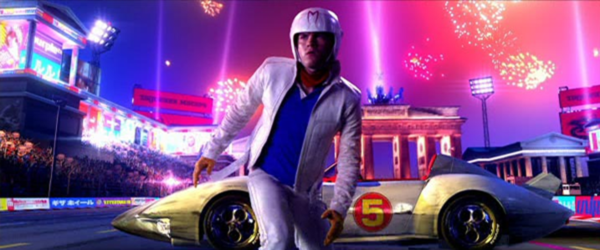
Image courtesy of Warner Brothers.
—
“Speed Racer” Directed by Andy and Larry Wachowski. Starring Emile Hirsch, Christina Ricci, John Goodman, Susan Sarandon. 135 minutes. Rated PG.
Del’s take
I hate animated films about as much as I hate films that synthesize animation with live action. And unless it’s “Batman” I am sick to death of comic book- and cartoon-inspired movies.
But instead of throwing up my lunch I simply threw up my hands and went with the hackneyed, cliched and utterly simple-minded “Speed Racer,” a movie in want of an audience dumb enough to enjoy it.
Despite its lurid color palette and fairy-tale plot, “Speed Racer” isn’t something kids will digest with their Happy Meals. Rather, it’s suffused with pell-mell destruction and adult themes of corruption, blackmail and death, most of which will go over the kiddies’ heads. But Mommy and Daddy can expect a grinding case of road rage over the money wasted on this interstate highway pileup of a flick.
The story goes like this: Young Speed (Emil Hirsch) grows up idolizing his older brother, Rex (Scott Porter), who is killed in a horrific wreck and accused of racing dirty, thereby sullying the family name. When Speed follows in Rex’s footsteps he is wooed by a large racing conglomerate headed by Mr. Royalton (Roger Allam), who threatens destruction upon the Racer family when Speed turns down his offer. Meanwhile the Togokahn racing organization, facing a hostile takeover by Royalton Industries, vows to win a final race, The Crucible, a cross-country destructo-derby where dirty tricks are the norm. They enlist Speed as a driver. If Togokahn wins the price of their stock will rise, bankrupting Royalton and exposing their race-fixing, and salvage the Racer family name.
Sounds like any number of little-guy-vs.-big guy potboilers, but what puts “Speed Racer” behind the pack is its lack of focus, thuddingly dense dialogue, dismissal of simple physics and jarring cinematography.
Where to begin? The brain swoons at the prospect. Is this a children’s movie or what? Should adults take it seriously? Are the overblown CGI effects a kind of commentary on the illusory nature of reality or merely the product of overzealous computer geeks?
Ultimately “Speed Racer” comes across as a rendering of “The Matrix” on Ecstasy, which is no coincidence: It was created by the Wachowski brothers, who guided the perpetually dazed and confused Keanu Reeves through his role as Neo in the otherworldly “Matrix” trilogy.
But unlike the original “Matrix” and the immensely satisfying “V for Vendetta,” the Wachowskis’ efforts are less successful here.
“Speed Racer” does not earn the checkered flag.

Mladen’s take
Ignore the bona fide movie critics, and Del, who pan the latest Wachowski brother’s effort. Rent “Speed Racer.” Make sure your subwoofer is working.
The plot is difficult to discern and the storytelling as blurry as the race scenes but what’s the big deal? No film is perfect.
Flashing unearthly psychedelic colors make the pseudo-animated movie a vivid delight. “Speed Racer” juxtaposes the dark plot with the cheerfulness of bright colors to say that shiny surfaces often disguise the evil beneath.
Pleasing-to-the-eye Christina Ricci, as Trixie, plays the role of an indomitable but discreet instigator with effective lightheartedness.
The actors portraying Spridle and ChimChim – or however the hell their names are spelled – add humor to the movie.
And, no kidding, John Goodman as Pops looks exactly like Pops in the “Speed Racer” cartoons.
Racers employ all sorts of dirty tricks against each other to keep, or get, lucrative corporate sponsorships. Races are fixed by bookies, an idea that the film’s makers could have ripped off from watching BCS college football computer models at work.
The vehicles depicted in the movie are beautiful. Powered by interlocking dihedral fusion c60 bucky balls or some such thing, the machines handle turns, loops, dips, jumps, sand, ice, rain, hot, cold, sideswipes, rearenders, frontenders, rocket-propelled grenades, hypoxia and the common cold with ease. It’s a wonder the driver’s weren’t fitted with G suits. Yes, the powerful Mach 5 and, later, Mach 6, have the gadgets featured in the cartoons and even some of the sound effects. Remember the “sproing” of the doohickeys that make the Mach 5 jump?
I would have preferred that “Speed Racer” the movie use as a plot something other than big business corruption and one boy’s push to keep the spirit of racing alive. What nonsense. All sports at all levels are about making money.
In fact, a pure action movie with no moral would have been ideal.
So, here’s the story for “Speed Racer” the sequel. A CG race against the Mammoth Car with the Car Acrobatic Team as its escort will blow off peoples’ socks. A subplot involving Racer X and the evil scientist who created the armored and tracker Car With A Brain must be worked in somehow. Finally, it would be helpful if in the sequel Speed reacts to Trixie’s sexiness with a thrill rather than dour sentimentality.
“Speed Racer” is worth watching. I’m thinking of adding it to my meager DVD collection, though not until the price drops to $5, or less.
Mladen Rudman is a former journalist and technical editor. Del Stone Jr. is a former journalist and author.
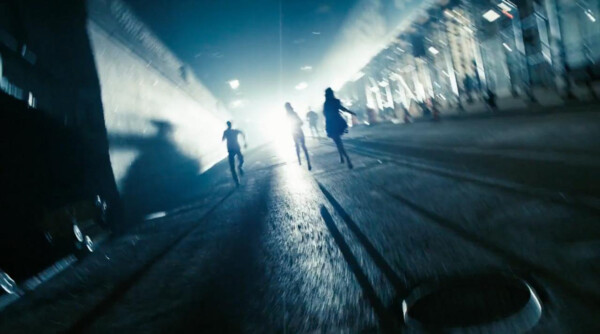
Image courtesy of Paramount Pictures.
—
“Cloverfield” Starring Lizzy Caplan, Jessica Lucas, T. J. Miller, Michael Stahl-David. Directed by Matt Reeves; created by J.J. Abrams. 85 minutes. Rated PG-13.
Mladen’s take
An amphibious monster, stories tall or a couple of blocks long, depending on the way you want to measure the beast, attacks Manhattan and it’s plausible.
That’s what makes “Cloverfield” work — the director takes the movie’s premise seriously.
Though “Cloverfield” sucks as a title, the movie becomes riveting after it finally cuts to explosions, toppled buildings, gunfire and missile and bomb attacks.
“Cloverfield” is realistic because it’s shot from the street-level point of view of a handful of people while the scaleless monster rampages through New York. The frenetic, jittery perspective you see on the big screen is captured by one of the survivors, who’s wielding a camcorder with the longest-lasting battery ever manufactured.
The CGI and the real blend flawlessly in this movie.
At any moment I expected cameraman Hud to focus on a still-functioning TV at an electronics story being looted as mayhem sweeps the island. President Bush comes on, the TV screen flickering.
“My fellow Americans, we are in a long war with monsters,” he would have said. “I don’t know when it will end, maybe never, but we will achieve victory. To protect you, I’m suspending all civil liberties and disbanding Congress. I can do that. It’s in the Constitution. Ask Dick Cheney. There’s no time for silliness like democracy while radical Islamic fundamentalist jihadist terrorists unleash such furry — ah, fury — on the good, holy people of America. God bless me, your savior.”
Like GM and Ford are finally starting to build cars that can compete with Japanese brands, Hollywood has finally released a movie that can compete with Japanese giant monsters such as Godzilla and Gamera.
See “Cloverfield” while it’s in theaters. Go to the bathroom and buy popcorn sometime during the movie’s first 20 minutes, which are spittle, and then prepare for a jolt.

Del’s take
“Scaleless monster”? Mladen. I never thought of you as a dermaphobe.
Still, “Cloverfield” is a romp ’em stomp ’em bad ass monster of a movie, and anybody who disagrees needs to have his aura adjusted by a Marine drill sergeant.
OK, so the first 20 minutes are more “Quarterlife” than “Die Hard.” So what? That’s the part where we learn the viewpoint characters are as insipid and selfish as we. How else could we know that Rob is a metrosexual wussie who believes “commitment” is a dish best served cold?
But once the infrastructure starts rolling down the streets it’s a cinema verite grudge match featuring the icons of order vs. the forces beyond our control in a mighty metaphor for what’s happening in the world around us. If the U.S. could have dropped the “Cloverfield” monster on Fallujah, Barack Obama would be running a distant third.
Yes, we can niggle. How could that monster jump at a helicopter? What happened to Marlena behind the curtain? And in the movie’s final scene, did you really see something fall into the water? Oooh.
I just wish people would stop Blair Bitching about the jiggly camera motion – take a dramamine and call me in the morning. Ever read “The Sound and the Fury”? William Faulkner thought of the idea decades ago. If you can live with it on YouTube you can live with it in “Cloverfield.”
I think J.J. Abrams has kicked some serious Godzilla booty. This is not narrative storytelling. It’s slice-of-death moviemaking for a generation of voyeurs and narcissists who measure their worth in terms of the body count on their Facebook friends list.
In the movie’s penultimate scene we hear two very loud noises. Those were the sounds of a genre cracking under the weight of its own inertia and crashing into a new and limitless ocean of creative expression.
Let’s hope “Cloverfield” sinks a few ships.
Mladen Rudman is a former journalist and technical editor. Del Stone Jr. is a former journalist and author.

(Clockwise from top) Martin Luther McCoy as Jo-Jo, Dana Fuchs as Sadie, T.V. Carpio as Prudence, Ekaterina Sknavina as Rita, Evan Rachel Wood as Lucy, Jim Sturgess as Jude, Kiva Dawson as MaxÕs Girl, Joe Anderson as Max, and Halley Wegryn Gross as Max's Girl in Revolution Studios' "Across the Universe." Photo Credit: Abbot Genser SONY PICTURES ENTERTAINMENT INC.
“Across the Universe” Starring Evan Rachel Wood, Jim Sturgess, Joe Anderson, Dana Fuchs, Martin Luther, and T.V. Carpio. Directed by Julie Taymor. Rated PG-13. 131 minutes.
Del’s take
About 15 minutes into “Across the Universe” I decided a review massacre was in order. By movie’s end, however, I had changed my mind. The movie didn’t work for me and I wanted to know why.
I thought about it all night. I used up precious REM sleep grinding my teeth on the issue. And sometime between bedrise and showertime I hit upon the answer:
Its moment had passed.
But not for the reasons you think.
“Across the Universe” is a homage to The Beatles, the ’60s, Vietnam War protests and the civil rights movement. It features Jude, a mop-topped lad from Liverpool who comes to America to find his father, who abandoned his mother in the Old Sod after World War II. Jude meets Max and falls in love with Max’s sister, Lucy. This unlikely trio hooks up with a New York crowd of artists and protesters who experiment with LSD, reinvent music and get clubbed in the head by truncheon-wielding cops.
The characters have an annoying habit of lapsing into song at almost every turn – re-mastered Beatles tunes as it were. The ratio of singing to storytelling is about 10 to 1. Unless you’re a huge fan of the Fab Four you’ll catch yourself rolling your eyes as Jude, frustrated by Lucy’s evolving radicalization by the anti-war movement, manifests his angst through a singing and strawberry-flinging hissy fit.
But the problem with “Across the Universe” is that it no longer works. The Beatles’ were replaced by new wave, grunge, hip-hop and emo. The “turn on, tune in, drop out” moment doesn’t exist. We have another Vietnam raging in the Middle East, and the civil rights movement has become a pale shadow of its former self.
More significantly, young people no longer feel the passion that once energized those social changes.
Back in the 1980s the kids were known as the “Me Generation.” But self-absorption on a cultural scale didn’t exist until the 2000s, when the gadget-pampered, media-beatified children of the ’80s and ’90s came of age.
The young people of the ’60s did what they did, no matter how wrong or stupid, because they were charged with a passion for revolution. At least some of them believed they could change the world.
But that passion is gone. Instead, we have a pretense of passion whose underlying motivation is self-aggrandizement, and it just rings hollow. People don’t march through the streets to bring change; they march through the streets to get on TV.
That’s why “Across the Universe” didn’t work for me. It was like watching Howdy Doody shout, “Hell no, we won’t go!”
When I see mobs of long-haired, placard-carrying hippies surrounding the White House and demanding that Bush pull out of Iraq, I’ll change my mind about “Across the Universe.”
Until then, I give it 10 big yawns.

Mladen’s take
A movie’s place in time shouldn’t influence its entertainment value.
“Across the Universe” is set in the turbulently kitschy 1960s but that doesn’t mean the movie needed to suck in the attention-deficit-disorder 2000s.
“Across the Universe” would have been crap in 1965, too.
Sweeping aside Del’s huffing and puffing about our selfish, publicity-seeking youth by noting that’s what all youth everywhere are at any given moment, leaves only the prospect of reviewing “Across the Universe” on its own merit.
The movie is little more than a montage of The Beatles songs. It would have been tolerable if more nudity and violence were offered, but that’s only two of several mistakes.
The creators of “Across the Universe” took Fab Four tunes and built a movie around them.
What they should have done was write a coherent script and cherry-picked The Beatles songs that fit. The result could have been both a good movie and a celebration of the Fab Four.
That said, I should come clean with a couple of prejudices.
First, the only thing good about The Beatles was Paul McCartney and that’s only after he founded Wings. “Live and Let Die” is one of the greatest songs ever.
And, second, “Across the Universe” fails to use The Beatles most whimsical and charming song, “Yellow Submarine.”
How can you produce, direct or act in a movie featuring The Beatles songs without using “Yellow Submarine?”
“Across the Universe,” in part, uses Vietnam War-era unrest in the United States as a component of its shtick.
“Yellow Submarine” could have been the song that gaps the inane decisions made by politicians back then with the gallingly obtuse decisions made, and being made, by the Bush administration today.
That would have had two effects.
First, Del might have been less grumpy in his review of “Across the Universe” because it had a link to the present.
And, second, the movie would have helped me survive the next 10 months of Bush.
After all, couldn’t we all “sail on to the sun until we found a sea of green and (live) beneath the waves in our yellow submarine” prosperously in international waters until Jan. 21, 2009?
Mladen Rudman is a former journalist and technical editor. Del Stone Jr. is a former journalist and author.
Video
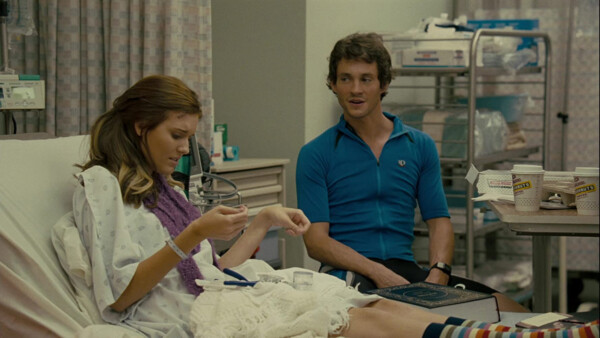
“The Jane Austen Book Club” Starring Maria Bello, Emily Blunt, Kathy Baker, Amy Brenneman, Maggie Grace, Jimmy Smits, Hugh Dancy. Directed by Robin Swicord. 106 interminable minutes. Rated PG-13.
Del’s take
When I suggested to Mladen we review something other than science fiction or horror I had no idea he’d go soft and squishy. But after consulting some of the ladies in our presence he came up with “The Jane Austen Book Club” which set my skin to crawling.
The words “Jane Austen” conjure an image of a spinster snuggled on the couch with her embroidery and her kitty cat, listening to classical music and fondly remembering the one and only night of her life that a beautiful man French-kissed her.
“The Jane Austen Book Club” stars the entire female population of Planet Amazonia, and Hugh Dancy. It is about a group of demasculating, wine-guzzling, teenage boy-seducing harpies who plot to subjugate the men in their lives by proposing an ultimatum: Read Jane Austen … OR ELSE. At least that’s what I got out of it.
Incredibly, the men cave to this ridiculous coercion and the movie wraps with a stomach-turning group cootie exchange.
Did I just give away the ending? Oh hell, I don’t care.
I find myself irritated by movies like “The Jane Austen Book Club.” The characters live in the most expensive state in the nation, wear stylish clothes, drive $40,000 Volvos, own mansions, don’t appear to ever work for a living … and wring their hands because hubby would rather watch a basketball game than rhapsodize about some lame English romance writer who died almost 200 years ago.
Gimme a break.
After watching “The Jane Austen Book Club” I felt the need to cleanse my palate with something more uplifting, like “Reservoir Dogs.”
Guys, do the words “chick flick” mean anything to you?
Stay away. Stay far, far away.
Ten million yawns.

Mladen’s take
I watched “The Jane Austen Book Club” on a Sunday night and the following day took a shower using French vanilla and cinnamon toast-scented shampoo.
I’m surprised Del, who’s far more cosmopolitan than me, didn’t react the same way.
The movie is a delicate, often charming, introspective about a group of people coping with maturing lives.
It was refreshing to learn that regular folks in Jane Austen’s time — she died in 1817 — also had to deal with the complexities of lovers found and lost and friends found and lost. Just knowing others across centuries have experienced what I have experienced is comforting.
The movie made me a more complete man.
OK, I’m lying.
“The Jane Austen Book Club” is a standard, putrid take on comfortable middle class people looking for purpose.
They use each other, commit adultery, make poor choices and, in the end, it all seems appropriate and normal and good and healthy. In short, it’s like the reading club members are running for president.
But, more than anything, what good is a movie that doesn’t need 7.1-channel, 75-watt per channel, DTS Neo:6 Cinema-filtered sound amplification to help get its message across?
None.
“The Jane Austen Book Club” has a running time of about 1 hour, 46 minutes and that means it was about 1 hour and 45 minutes too long.
Mladen Rudman is a former journalist and technical editor. Del Stone Jr. is a journalist and author.
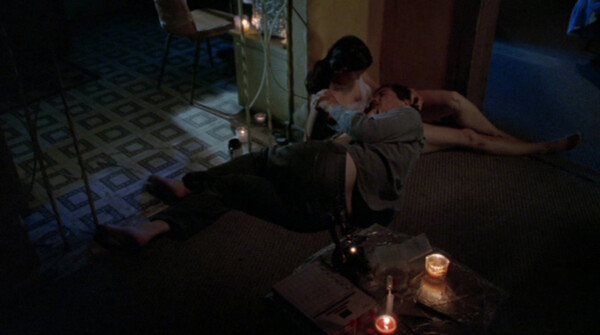
“Bug” Starring Ashley Judd, Michael Shannon, Harry Connick Jr., Lynn Collins. Directed by William Friedkin. 102 minutes. Rated R.
( Warning: Spoilers follow. )
Mladen’s take
Aside from seeing Ashley Judd naked and one moment of exquisite acting, I’m hard-pressed to find anything good about the movie “Bug,” recently released on DVD.
Granted, I’m no Einstein, but having to turn to the director’s explanation of the movie to figure out its meaning is reason enough to dislike the depraved, violent effort. Then, as it turned out, not even the director sounded like he understood the movie.
“Bug” is incomprehensible because there’s no reference point.
Is Peter Evans, played by Michael Shannon, really an Army soldier gone AWOL after being injected with some experimental concoction that makes him believe he’s being attacked by nearly microscopic aphids? Or is he just crazy?
And, how could he persuade Judd’s character, Agnes White, that she should help, and stay with him, after he contaminates her and her grungy motel-room home with the “bugs”?
Yes, White is vulnerable emotionally because the memory of her 6-year-old son disappearing while they grocery shopped shadows her every move, but would that make her gullible enough to self-immolate, with Evans, to end the movie?
The most sympathetic character in the film, ironically, is White’s abusive ex-husband played beautifully by Harry Connick Jr. in the role of Jerry Goss.
There’s a scene — it’s about two seconds long —where Goss, the wife-slapping ex-con, becomes more sympathetic, even human, than White or Evans ever could.
The moment is played with such stunning heartbreak that, all by itself, it damn near saves the film … damn near but not quite.

Del‘s take
Somebody hand me a can of Raid. I’m gonna spray this vile movie until it curls up and dies, like an invading midnight cockroach.
“Bug” is shocking because it highlights the kind of crap that passes for art these days – gratuitous violence inflicted by unsympathetic lunatics on self-appointed victims.
It’s one of those spiral-into-insanity kinds of films that invites us along for the ride. But after seeing this wreck weave back and forth across the center line I bailed and called the cops.
The Judd character is an unlikable victim whom we’re led to feel sorry for – sorry, I didn’t – because her kid was abducted. Her solution: stay drunk and beaten up.
The guys in her life are slimeballs who should be put away in cells – one, prison; the other, padded.
The story is … well, there IS no story. It’s just an extended vignette drenched in mayhem, madness and murder.
No law requires that a movie edify or enlighten. But it MUST entertain, and I ask: What’s so fun about watching two nutcases dissect each other?
Nothing – unless you’re a fan of hernia exams.
Don’t see “Bug.” Spray it. Step on it. Sic the cat on it.
Mladen Rudman is a former journalist and technical editor. Del Stone Jr. is a former journalist and author.
Video
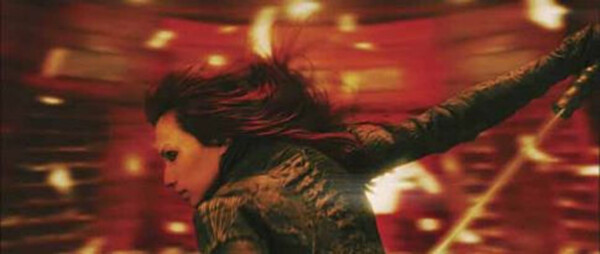
“Casshern” Directed by Kazuaki Kiriya. Starring Yusuke Iseya, Akira Terao, Kanako Higuchi. 142 minutes. Unrated.
Mladen’s take
A confession.
Without Del explaining between sets of kicking my butt in tennis what “Casshern” was about, I’d still be scratching my head.
The plot, as it turns out, is semi-unoriginal.
Corrupt politicians of a militaristic superstate collude with malignant corporation bosses to create a dystopian wonderland of carnage where healthy humans are involuntarily used as tissue donors.
Meanwhile, the leader of a small cell of mutants created by a bolt from the Universe that pierced the occluded sky of Earth and hit a vat of artificially growing human limbs promises to avenge the mistreatment he suffered at the hands of government security forces.
Then, from same vat that birthed the mutants, arises a hero.
And, he shall be called Casshern.
Casshern, with his body armor-integrated George Jetson-like rocket pack and morphing helmet tries his dangedest to keep the superstate and mutants from destroying everything, but fails.
Or something like that.
The convoluted plot of “Casshern” is tough to follow but the Japanese movie held me captive for no other reason than background details. They were gloriously presented with cinematography resembling a blend of “Brazil,” “Sin City,” and the “Kill Bills.”
In the movie, the society spoke Japanese but wrote in Russian, I think.
Tanks and flying machines are clunky, mechanical beasts as pragmatic and ugly as the imploded society that created them.
The army of robots organized by the mutant leader from leftovers of an earlier conflict march lockstep, their heads adorned with helmets that look like Kraut head gear of World War I.
The landscape, baked by industrial waste, is brown-red-gray. Only the rich enjoy green grass and gardens filled with blooming flowers.
Most striking is the intermodal concentration camp.
Spanning several sets of rails, the prison train pulls cars loaded with shipping containers. The containers are placed aboard by multiple rotor helicopters. Inside the containers are healthy humans.
The train set is used by the cabal that runs the superstate to store and process the healthies. They’re used as DNA feedstock for a covert genetic engineering program designed to keep the aging rulers alive.
“Casshern” is no fairy tale. It’s bleak from beginning to end. People are nothing more than a commodity to be exploited. The compelling film brims with treachery. And, maybe someday, after I’ve watched it again and again, I’ll understand the plot and its half-dozen subplots.

Del’s take
I came across “Casshern” in the $3 bin at Big Lots and decided to take a chance. I don’t have a problem with anime-inspired stories and I love Japanese horror movies including Hideo Nakata’s “Ring” and Takashi Shimizu’s “Ju-on.”
I won’t reproduce Mladen’s summary of the plot because I think it’s pretty well spot-on. Like Mladen, I had a tough time following the plot – especially with the rapid-fire pacing that meant subtitles appeared and disappeared so quickly I found myself reading more than wallowing in the lush visuals.
And they are lush. Americans aren’t quite acclimated to the look of anime. I can think of only one American director – Ridley Scott – who imbues at least some of his films with a similar attention to visual detail (“Blade Runner” and “Legend”). The intermixing of high-power CGI with live action to produce a poetic vision is something Japanese directors expect the audience to accept. In America it’s CGI made to resemble live action. In Japan it’s CGI that makes no apologies for itself.
Like many anime-inspired stories “Casshern” is a bit heavy-handed with the subtext. Running throughout is a not-so-subtle criticism of science, the stifling hand of cultural authority, the loss of environmental sanctity, and the violence to which humanity seems perpetually addicted.
But there were surprises. The role of parents as enforcers of cultural authority, the impotence of love vs. that authority – these are strange notions to a Westernized society that has been taught the individual trumps the collective.
More than likely “Casshern” is a standard and perhaps cliched statement movie about the triumph of the will … and the hubris of the willful. But if you can get past the convoluted plot, the sometimes unintentionally humorous dialogue (perhaps resulting from a less-than-perfect translation) and the cultural differences that divide East and West, you might enjoy the movie.
What you will enjoy is the “look” of the movie. Almost every frame produced a sense of awe, masterfully crafted by music video director Kiriya. While some may argue “Casshern” delivers empty calories, think of all the empty calories in your life, from french fries to text messages.
I recently watched “Predators” at the movie theater. I spent $9 on a ticket and $6 on a small bag of popcorn. For the journalists among us that’s $15, or five movies from the $3 bin at Big Lots.
I would much rather have spent that $15 on five movies like “Casshern.”
Mladen Rudman is a former journalist and technical editor. Del Stone Jr. is a former journalist and author.
Video